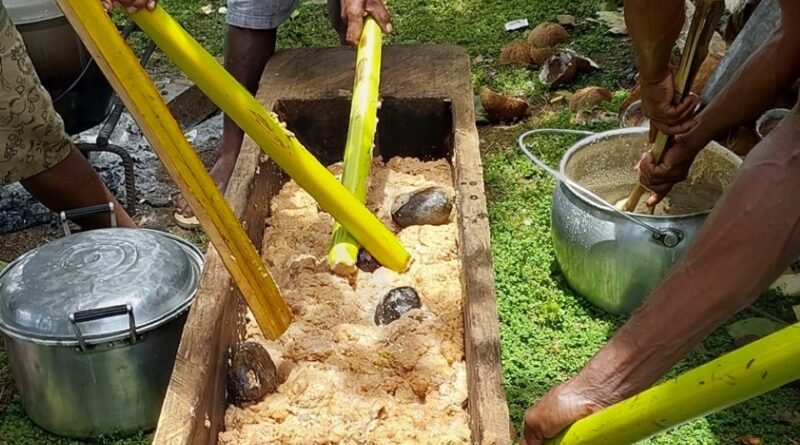Makira’s Traditional Hohorau Wooden Bowl
BY CHRIS ALEX
IN the heart of Makira Ulawa province, a remote island paradise in the Solomon Islands, lies a cultural treasure that embodies unity, tradition, and the joy of sharing food.
Known as Hohorau or Hohoto, this colossal wooden bowl plays a central role in the vibrant ceremonies of the Makira Ulawa people. This traditional wooden bowl is also renowned for making the traditional Makira food called the ‘six months pudding’.
TOURISM MEDIA will take you on a journey into the significance of Hohorau and the captivating commissioning process it undergoes, transforming it from a mere utensil into a vessel brimming with cultural heritage and communal spirit.

Symbolic Essence of Hohorau
Hohorau is more than just a practical tool for the people of Makira; it is a symbol of their cultural identity and the values they hold dear.
During important ceremonies like weddings, feasts, and communal events, Hohorau takes center stage as the vessel of choice to make a traditional pudding that holds great significance within their culture. It represents the unity and togetherness of the community as people gather around to share in the joy of food and celebrate their shared heritage.
Intriguing Commissioning Process
Before Hohorau can fulfill its vital role, it must first undergo a transformative process known as Horohau.
This commissioning process is a meticulous ritual that not only ensures the bowl’s readiness but also infuses it with spiritual essence and blessings from the community.
Burning Ritual
At the heart of the burning ritual process is the burning of the Hohorau with hot stones and coconut shells.
This fiery baptism serves multiple purposes. Firstly, it cleanses the wooden bowl, removing any dust and fibres that may have accumulated during its construction. This meticulous cleansing ritual ensures the utmost cleanliness, reflecting the importance placed on purity and hygiene in Makira’s culture.

Strengthening the Bowl
Additionally, the burning process aids in strengthening the Hohorau. Crafted from green wood, the bowl initially possesses a certain toughness that makes it less prone to cracking. The controlled burning helps shrink the wood’s grains, making the bowl even stronger and capable of withstanding the pounding required during the preparation of the traditional pudding. This reinforcement ensures that Hohorau can serve its purpose with durability and resilience.
Spiritual Transformation
Beyond its physical enhancements, the Horohau process imparts a spiritual essence to the Hohorau.
The belief is that as the flames lick the wooden surface, the bowl becomes imbued with positive energy and blessings from the community. This spiritual infusion is said to enhance the significance of the ceremonies in which Hohorau is used, making it a vessel of auspiciousness and prosperity.
Significance of the Six-month Pudding
Once the commissioning process is complete, the Hohorau is ready to fulfill its central role in Makira’s cultural celebrations. It becomes the vessel for making a special six-month pudding that holds deep meaning for the community.
This delectable treat, known as the six-month pudding, is crafted with love and care, symbolizing the patience and dedication required to preserve tradition. The Hohorau takes on a new identity during these ceremonies, becoming a focal point that brings people together, fosters camaraderie, and creates cherished memories.
Testament to Tradition
Hohorau, the gigantic wooden bowl used for making the six-month pudding, stands as a testament to the rich traditions and customs of Makira. Through the commissioning process of the Horohau, the Hohorau is transformed into a vessel that goes beyond its physical form. It becomes a symbol of unity, cultural heritage, and the joy of sharing food within the community. As Hohorau takes its place at the heart of Makira ceremonies, it enhances the experience, bringing people closer and creating lasting memories. Cherished by present and future generations, Hohorau remains a living testament to Makira’s vibrant cultural tapestry.



